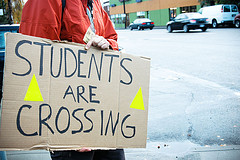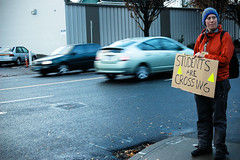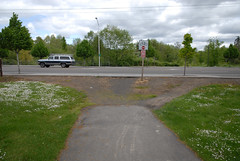It’s common at advocacy-oriented conferences to hear the latest horrible stats about how bad things are and how it’s up to the great work of advocates to charge into a new era and change the world.
At the Safe Routes to School National Conference being held in downtown Portland this week, attendees just got all fired up from a keynote by Richard Jackson, and M.D. and Professor of Environmental Health Sciences at UCLA.
“…all I’ve heard is that it can take up to 5 or more years to put in a crosswalk and make the necessary infrastructure changes so that the kids who live 1/4 mile away from school will be able to walk and bike.”
— From a comment yesterday made by a woman in Beaverton
He implored the crowd to work harder in tying transportation reform to the health agenda and spoke with great urgency that work being done with Safe Routes programs are essential to reversing dire trends in obesity, climate change, and so on.
In addition to health, another major theme at the conference this year is school siting. A major reason that the percentage of kids who walk about bike to school has plummeted in the last four decades is that schools are being built in locations that make biking and walking nearly impossible.
One reason for this is an attempt by districts to save money and buy cheap land on the outskirts of town. There is also a trend toward mega-schools. In a session yesterday we learned that from 1968-2001 there were 1,000 less schools and 2 million more students. National Safe Routes leaders are pushing for flexible, smaller, neighborhood schools where students can have more transportation options. They are also working to teach school boards that there is no minimum acreage requirement for new schools (some incorrectly believe that one exists).
With all of that swirling around my head, a comment came in yesterday that made these challenges and stats very real. Someone named “Elaine” left a comment about her experiences trying to improve the transportation environment around a new public school in Beaverton (about 8 miles west of Portland).
She wrote (emphasis mine):
“As a PE teacher helping to open a new public school in Beaverton, I find myself up against a slightly different battle. Our school lies just north of a busy Washington County Rd with a 45 mph speed limit, and within a new housing development (which does have good sidewalks). The sidewalks and bike lanes along this main road (south of the school) are limited, but many of the neighborhoods that will feed into the school have great walk and bikeability.
It’s really just this one busy road that’s the crux. There is no designated crosswalk to get kids across this busy intersection and into the neighborhood where this school is located.
I’ve tried connecting with Safe Routes, the BTA, Washington Co DOT, and our Districts’ transportation department. Unfortunately, all I’ve heard is that it can take up to 5 or more years to put in a crosswalk and make the necessary infrastructure changes so that the kids who live 1/4 mile away from school will be able to walk and bike.
For the forseeable future and starting this September almost 450 of our 500 kids will be bused from 1/4 mile away for the next few years. It could cost the district so much more in transportation costs then it will to install some crosswalk signs.
I’m frustrated more with the planning side of this, when areas get developed, and why sidewalks and crosswalks are not mandated by a town, city or county before construction takes place. It’s a safety issue and a public health issue.
We do have some enthusiastic parents at our school who are also passionate about walking and biking to school. I hope they can make some noise and get things moving along faster than 5 years.”
Elaine touches on many issues that are at the heart of the Safe Routes movement today. Bus transportation has for years been considered the only other option than private car to get kids to school. But buses are far from an ideal option: They pollute, they create a traffic hazard, and they don’t do much to combat the obesity epidemic. At a session yesterday, the State Network Coordinator for the Safe Routes to School National Partnership told attendees they should “think outside the bus”.
Elaine’s story also brings up the importance of “complete streets” policies and how they might be connected to Safe Routes. The Bicycle Transportation Alliance is well aware of this issue. Last legislative session they introduce a bill (SB 276) would would have required school districts to “consider effect of school site selection on transportation costs to school district and to families of school children”.
The issue of network connectivity is also at play here. Washington County has a lot of off-street trails, but they rarely connect directly with commercial areas. I experienced this first hand when I took a ride out there back in May.
Elaine is up against a lot. For years, battles like hers have been waged by local activists and advocacy organizations. In Portland, we’re fortunate that many of our City engineers and planners are also advocates who understand and care deeply about these issues.
But what about Beaverton and rest of America? It’s time the federal government started making these issues a higher priority. Hopefully we see major reform around these issues in the new transportation bill; that is, once the Obama Administration is done with other, more important things.




